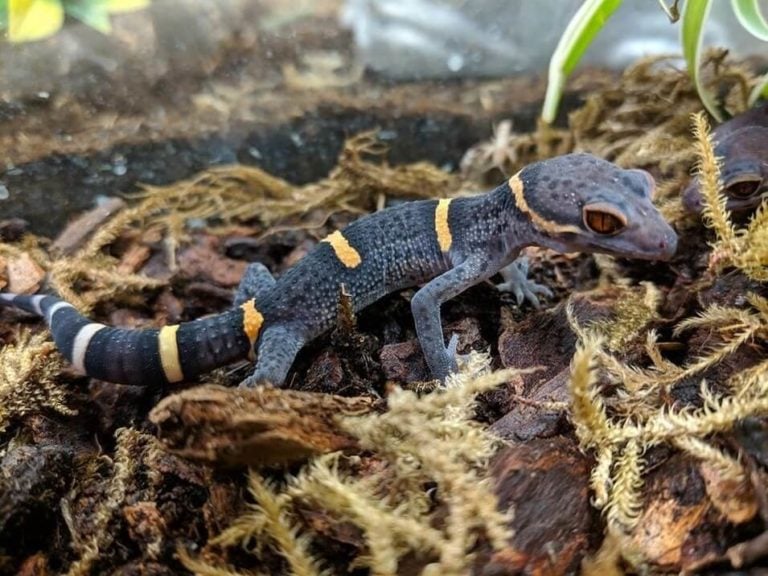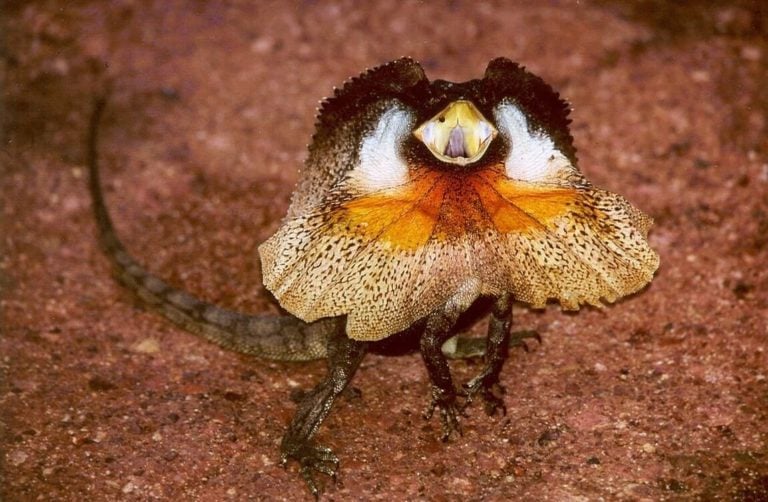The life of lizards has many pleasant and interesting moments, for example, some of these reptiles can ‘swim’ as if on the water! This makes it possible for them to move across the water surface, especially to escape from predators or in the process of hunting for fish or other animals.
Among these, the most famous are the green basilisks, or ‘Jesus Christ lizard’ of the genus Basiliscus. These green basilisk lizards are also able to run on their hind legs on the surface of the water and hence their feet are often seen to seem as if they are walking on water.
Basilisks Lizard Scientific Name
The scientific name of this water-running lizard is Basiliscus — which means “little king.” The genus covers its four unique species, namely:
- B. basiliscus
- B. vittatus
- B. galeritus
- B. plumifrons
These four species are from the Reptilia class of Corytophanidae.

Interesting Facts about the Basilisk Water Running Lizard
- Males have crests on their heads that extend forward and become more pronounced during the breeding season. The size and the color intensity of the crest are said to convey dominance and profitability to potential mating partners. Harvard University studied these crests as they play an important role in mating season.
- Basilisk lizards are well-developed in vision and ability to judge distances; this is particularly important when they rapidly churn in hunting or when jumping over rocks.
- There is no parental care among basilisks, baby basilisks are born they are small but fully developed and do not require anyone to take care of them.
- Basilisk lizards can perform autotomy, which is the process of losing the tail consciously. It will still crawl even after dropping it which will create a form of diversion as the lizard drops its tail.
“Jesus Christ” Lizard Evolution and Origins
Green basilisks’ prehistoric forefathers were once inhabitants of the tropical forests in present-day Wyoming, and that was 48 million years ago.
The green-crested basilisk lizard resides in Costa Rica, Honduras, Nicaragua, and Panama’s tropical rain forests, from sea level right up to 2,542 feet.
These lizards prefer arboreal and terrestrial habitats close to water bodies. The green basilisk lizard is peculiar for its ability to run due to its long back legs, long toes, extra flaps, and scales. This is also possible because of their unique three-dimensional force generation that allows them in creating and generating sufficient vertical force and lateral reaction forces and avoid sinking.
When it runs fast, it steps on its rear feet and forms tiny bubbles of air so as not to sink its toes and make it look like it is walking on water for a few seconds.
Basilisks Appearance
Basilisk lizards are quite colorful and are one of the most beautiful reptiles in the world. They wear coats of many colors, often red, green, blue, or yellow and this makes each one of them easily distinguishable. These colors assist in the identification of the different kinds.
The common basilisk is brown with cream in color with a combination of the two colors. At the same time, the plumed basilisk also known as the double-crested basilisk boasts high crests, and greens that glisten like the sea, sometimes with streaks of blue.
They have a yellow underbelly and there are marks on their body and neck which make them quite conspicuous. The green basilisk has a long tail which is three times longer than the whole body of the snake. In general, they are about 2.5 in size.
They have long toes and rear feet that can bend in awkward angles and their bones are also quite lightweight, which allows them the ability to run on water and solid surfaces as if by magic.

the plumed basilisk also known as the double-crested basilisk
Behavior
That Basilisk Lizard is quite something, but it is best not to get too close to this creature. They are somewhat shy and prefer not to be around people or come into contact with them. Popular for their ability to run on the surface of water, they employ this to evade danger or even when in search of food.
Only a few basilisks like the company of others of their lizard kind. They can frequently be seen looking for some food or just lying down to catch some sun near the surface area of the water body. At nap time, they can climb a tree, sometimes to the height of 20 meters!
Diet
For the basilisk lizards, each type has the food that it prefers to eat. The plumed basilisk lizard feeds on frogs and fish as it is a water-preying snake that is active by the streams.
The red-headed basilisk feeds mainly on bugs; occasionally it will snatch tiny water animals, other small vertebrates, and on rare occasions a fish. The common basilisk also feeds on these but also takes river crabs, small birds, other reptiles, and small mammals. Young, common basilisks are also fond of bugs as food.
It is a non-fussy reptile and will feed on a variety of foods. It feeds on water insects, any insects it can find, jumping grasshoppers, and some of the desert insects that can sting to defend themselves.
Habitat
To meet the rare plumed runner one has to go to the rainforests of Central America and South America. This reptilian inhabitant of the rainforest is seen mostly in the vicinity of rivers, run on water, and rapidly churn on streams that it gracefully glides over. Its territory is the riparian area and it dominates this area as a fast and powerful hunter.
These amazing lizards are versatile in their movement on water and trees, as documented by National Geographic. They are known to live up to an altitude of 775 meters above sea level not a very short distance. They inhabit the regions that include water and woods, and this clearly shows their adaptability.

Reproduction and Life Cycle
The reproduction cycle of the basilisk lizard is a marvel of evolutionary biology and interesting in its way. Males mate with several females on the other hand female basilisks only mate with one male. They normally produce 4 clutches in a year with each clutch being 20 eggs and they place them in a trench, an action that demonstrates the tortile form of legged locomotion they possess.
The eggs take 6-10 weeks to hatch and the larva takes 2 full days to come out of their eggs. These hatchlings then swim, walk on water, and walk on the land immediately after hatching. Surprisingly, they can even climb trees and swim as soon as they are born, or maybe even before that, proof of the longer functions of their limbs.
Not very dependent on anyone and from the beginning, these lizards are on their own and do not need anyone to take care of them to be healthy. By the time they are ten months old, they become sexually mature and look for their partner to reproduce.
Lifespan for these creatures varies and can live up to 7 years in captivity while in the wild, their life expectancy is relatively shorter due to predators such as large birds, fish, snakes, and other reptiles.
Basilisk Lizards as Pets
- Habitat: Originally from Central America and South America, animals can be found in tropical environments.
- Enclosure: Adults need a big enclosure of 55-75 gallons with climbing Gaudi and UVB light.
- Nutrition: Thus, a diet of insects with a certain proportion of plant material is necessary.
- Temperature and Humidity: Aim at keeping it between 68-77°F during the day and the basking zone with a temperature of 80-85°F and humidity levels of 60-80%.
- Water Features: There has to be a large water space for swimming as basilisks are partially aquatic creatures.
- Handling: They are sensitive animals, and therefore one should avoid handling them as they get easily frightened.
- Suitability: Suitable for experienced reptile lovers, but not for newcomers because of the certain conditions of living with these creatures.
If you’re an animal lover this basic tip list should allow you to decide if the basilisk lizard is the right pet for you.
Green Basilisks Population
There are 4 main species of Basilisks in the world: Some of the common types of basilisk resorts; the red-headed basilisk, the common basilisk, the striped basilisk, and the plumed basilisk. It is not known how many of the present basilisks there are. However, professionals have noted that they are not threatened species and will not be gone shortly from natural history.
Predators and Threats
The green basilisks are almost always on the front only generating force to run on water in a bid to escape the sadistic predators that are after them. This includes large birds, fish, and other reptiles such as the snake. They protect themselves because they are fast and can easily move across water barriers.
Frequently Asked Questions
How do Basilisk lizards run on water?
Basilisk lizard can run on water, with a technique of thumping their feet, and toes on the water’s surface to reduce their body weight and form buoyancy to make them float. The ability to move quickly and lightly – their feet and toes hardly touch the ground – enables them to run over water.
What is a common basilisk lizard?
The common basilisk lizard is a species of lizard, which has the properties of running on the surface of the water with two legs for a certain distance and for this reason, it is called the ’Jesus lizard’.
How do basilisk lizards defend themselves?
Being a prey species, basilisk lizards are also capable of escaping predators by running swiftly on their hind feet and supporting limbs, inflating their bodies to make them look big and threatening, or leaping into the water in an attempt to evade the predator. They are also swimmers with excellent swimming skills.
Do basilisks eat lizards?
These lizards aren’t picky eaters – they’re omnivores, meaning they eat various foods. Their diet includes insects like beetles and dragonflies, plants and flowers, and even small animals. They might snack on a tiny snake, another lizard, a bird, some eggs, or a fish if they find them. It’s all about survival and making the most of what’s around them in their habitat.




